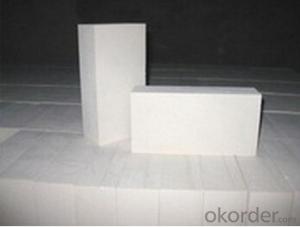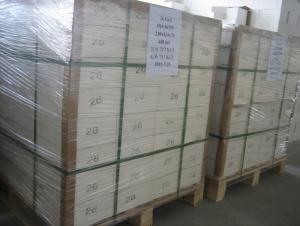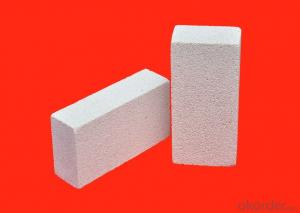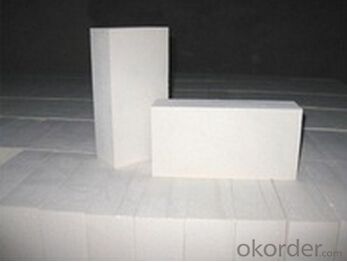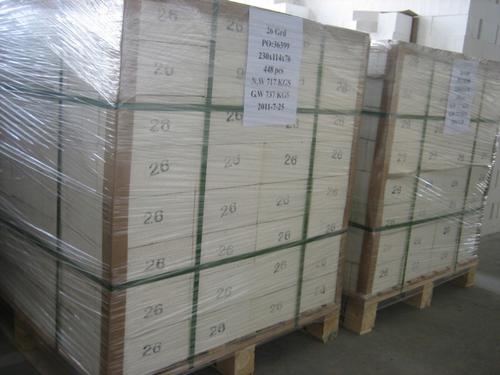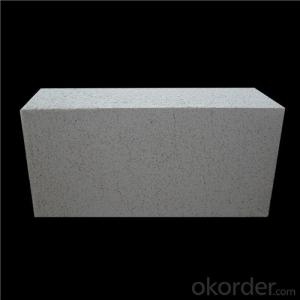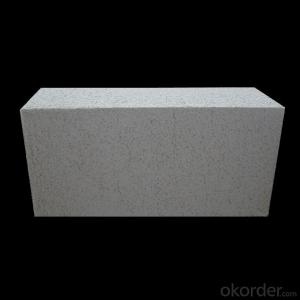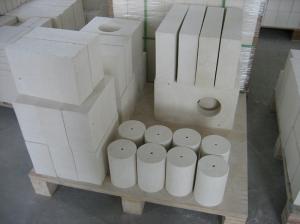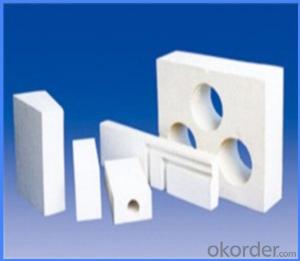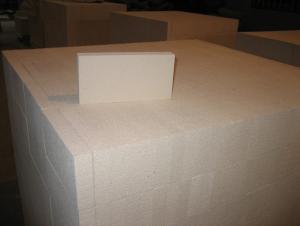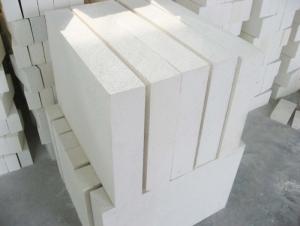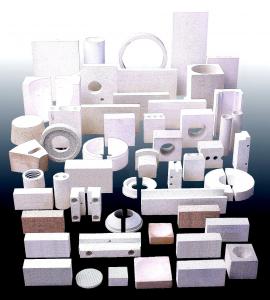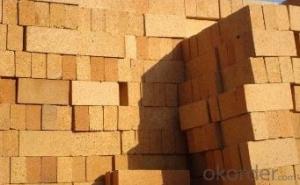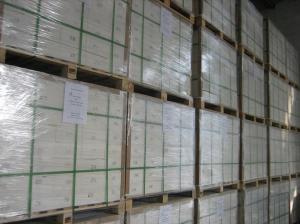Insulating Fire Brick - Refractory Mullite Insulating Refractory Brick JM 40
- Loading Port:
- Shanghai
- Payment Terms:
- TT OR LC
- Min Order Qty:
- 20 m.t.
- Supply Capability:
- 20 m.t./month
OKorder Service Pledge
OKorder Financial Service
You Might Also Like
General Information
CMAX insulating firebricks are classified under temperature between 1300℃ to 1700℃, manufactured from high purity alumina clay.
1. Lower content of iron, alkaline and impurities, good high temperature properties.
2. Homogeneous structure, light weight, energy saving because lower heat storage in the furnace during cooling cycles.
3. High strength, good thermal shock resistance under high temperature.
4. Precise sizes due to grinding and shaping after sintering, which meets the requirement of construction.
5. Max service temp: Up to 1730C (3160F)
Feature
Light weight and low thermal conductivity
Low heat storage
Low iron and impurities
High thermal shock resistance
Application of Insulating brick
Metallurgical Industry: blast furnace, hot blast furnace, heating furnace, etc..
Petrochemical Industry: ethylene cracking furnace, hydrogen furnace, the main furnace, heating furnace, etc..
Ceramic industry: roller kiln, kiln, etc..
Glass industry: glass furnace regenerator, etc.
Carbon industry: carbon furnace, etc..
Aluminum electrolysis industry: aluminum reduction cell, etc.
Other industries: tunnel kiln, shuttle kiln, etc.
Advantages of heat insulation brick
Low thermal conductivity: many air holes will bring good thermal insulation effect, energy saving.
High crushing strength: high crushing strength, volume stability.
Low heat storage: small heat storage, absorb more heat, energy-saving effect is obvious.
Technical Data
ITEM | GJM30 | GJM28 | GJM26 | GJM23 |
Classification Temperature, ℉/℃ | 3000/1650 | 2800/1540 | 2600/1430 | 2300/1260 |
Bulk Density,g/cm³ | ≤1.0 | ≤0.9 | ≤0.8 | ≥0.5 |
Reheating Linear Change, % | ≤0.9 (1550℃,12 h) | ≤0.8 (1510℃,12 h) | ≤0.7 (1410℃,12 h) | ≤0.5 (1230℃,12 h) |
Al2O3 Content, % | ≥75 | ≥65 | ≥55 | ≥45 |
Fe2O3 Content, % | ≤0.5 | ≤0.6 | ≤0.7 | ≤1.0 |
Thermal Conductivity: | ||||
800℃, w/m.k | ≤0.39 | ≤0.37 | ≤0.35 | ≤0.18 |
1000℃, w/m.k | ≤0.43 | ≤0.41 | ≤0.39 | ≤0.20 |
1200℃, w/m.k | ≤0.48 | ≤0.46 | ≤0.43 | --- |
Insulating brick
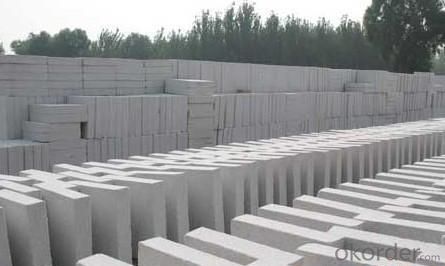
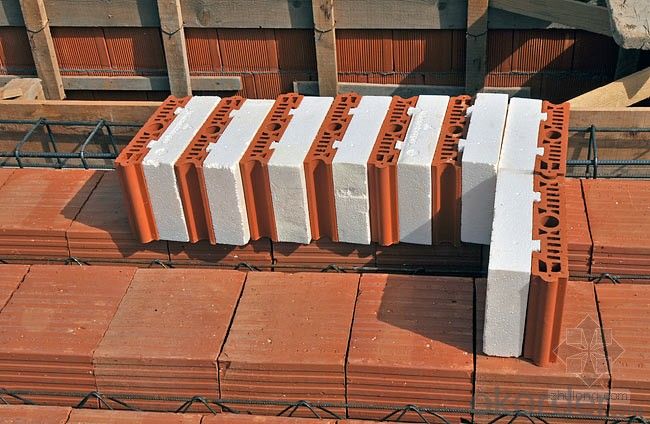
- Q: Are insulating fire bricks resistant to carbon monoxide attack?
- Yes, insulating fire bricks are resistant to carbon monoxide attack. These bricks are designed to withstand high temperatures and are made from materials that have low thermal conductivity. This makes them highly resistant to chemical reactions, including carbon monoxide attack.
- Q: Do insulating fire bricks have a high fireproof rating?
- Insulating fire bricks indeed have a high fireproof rating. These bricks are specifically designed to withstand extremely high temperatures and provide excellent insulation against heat transfer. They are made from special refractory materials that have low thermal conductivity, which helps in retaining heat and preventing it from escaping the system. Insulating fire bricks can withstand temperatures ranging from 2300°F to 3100°F (1260°C to 1700°C), making them ideal for use in furnaces, kilns, fireplaces, and other high-temperature applications. Their high fireproof rating ensures that they can effectively protect structures and equipment from the intense heat and flames, allowing for safe and efficient operation in various industries.
- Q: Are insulating fire bricks resistant to abrasion or wear?
- Insulating fire bricks possess resistance to abrasion and wear. These bricks are crafted using top-notch refractory materials, like alumina or silica, that exhibit exceptional resistance to abrasion. Through the manufacturing process, the bricks are subjected to high-temperature firing, which enhances their durability and fortifies them. Insulating fire bricks are explicitly engineered to endure the demanding conditions found in high-temperature applications such as furnaces, kilns, and fireplaces. They exhibit high resistance to thermal shock, chemical erosion, and mechanical wear. As a result, they serve as a dependable option for insulating and safeguarding the inner walls of these structures, thereby ensuring long-lasting performance and reducing the need for frequent replacements.
- Q: Do insulating fire bricks require any special sealing or caulking?
- Insulating fire bricks generally do not require any special sealing or caulking. These bricks are designed to have low thermal conductivity, which means they already provide good insulation on their own. However, in certain specific applications or when exposed to extreme temperatures, some sealing or caulking may be necessary to ensure optimal performance and prevent any heat loss or damage. It is recommended to consult the manufacturer's guidelines or a professional for specific sealing requirements in such cases.
- Q: Can insulating fire bricks be used in boilers for steam generation?
- Yes, insulating fire bricks can be used in boilers for steam generation. Insulating fire bricks have excellent thermal insulation properties, which help to minimize heat loss and increase the overall energy efficiency of the boiler. Additionally, their high temperature resistance makes them suitable for the high heat and pressure conditions present in steam generation applications.
- Q: Is it possible to recycle broken insulating fire bricks?
- Yes, it is possible to recycle broken insulating fire bricks. Insulating fire bricks are commonly made from materials such as clay and alumina, which can be recycled. The broken bricks can be crushed into small particles or ground into a fine powder, and then mixed with other materials to create new bricks or other construction materials. Additionally, some recycling facilities may accept broken insulating fire bricks and process them for reuse in other industries. Recycling broken insulating fire bricks helps to reduce waste, conserve resources, and minimize the environmental impact associated with manufacturing new bricks from scratch.
- Q: Can insulating fire bricks be used in the construction of lime production linings?
- Yes, insulating fire bricks can be used in the construction of lime production linings. These bricks are designed to withstand high temperatures and provide insulation, making them suitable for lining furnaces and kilns used in lime production. They can help maintain the desired temperature, conserve energy, and improve the efficiency of the lime production process.
- Q: Can insulating fire bricks be used in the construction of steel rolling mills?
- Yes, insulating fire bricks can be used in the construction of steel rolling mills. These bricks are designed to withstand high temperatures and provide excellent insulation, making them suitable for lining furnaces, kilns, and other industrial applications. Using insulating fire bricks in steel rolling mills can help maintain stable temperature conditions and improve energy efficiency during the rolling process.
- Q: How much is a thermal brick?
- Insulation brick prices also have a great relationship with the material and workmanship, such as clay brick price is much lower than high alumina brick, mullite and corundum brick prices will be higher.
- Q: How does the density of an insulating fire brick affect its performance?
- The density of an insulating fire brick directly affects its performance. A higher density brick usually offers better insulation properties, as it contains more air pockets that prevent heat transfer. On the other hand, a lower density brick may have reduced insulation capabilities but can be more lightweight and easier to handle. Therefore, selecting the appropriate density for an insulating fire brick is crucial in achieving the desired level of insulation and overall performance.
Send your message to us
Insulating Fire Brick - Refractory Mullite Insulating Refractory Brick JM 40
- Loading Port:
- Shanghai
- Payment Terms:
- TT OR LC
- Min Order Qty:
- 20 m.t.
- Supply Capability:
- 20 m.t./month
OKorder Service Pledge
OKorder Financial Service
Similar products
Hot products
Hot Searches
Related keywords
